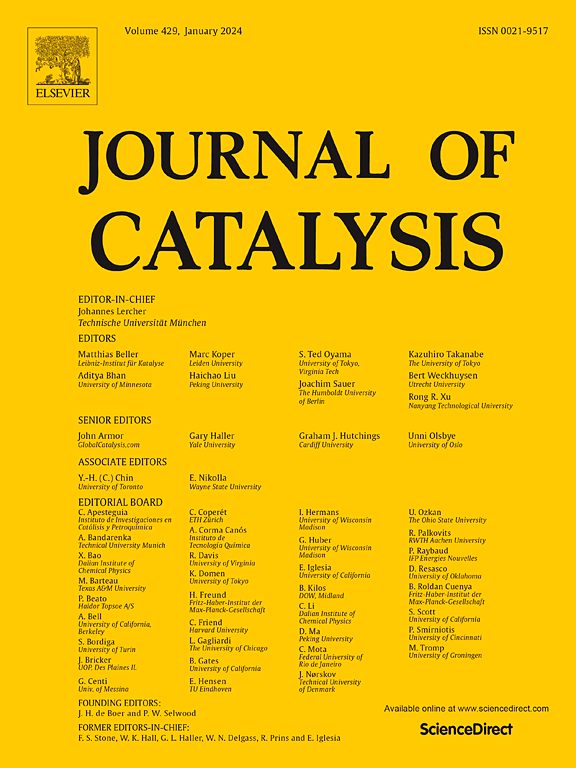Catalytic utilization of transition, post-transition and rare earth metal-substituted brownmillerite-related solids for the continuous-flow hydrogenations of CO2 and furfural into synthetic fuels
IF 6.5
1区 化学
Q2 CHEMISTRY, PHYSICAL
引用次数: 0
Abstract
Brownmillerite-type perovskites (or called dicalcium ferrite derivatives, Ca2Fe1.4M0.6Ox), as excellent candidates for Earth-abundant catalysts, were tested in gas- (CO2) and liquid-phase (furfural) hydrogenations for the first time. Preparation of precursor forms of catalysts using a variety of metals M(III) = Al, Sc, Cr, Mn, Fe, Co, Ga, Y, Rh, Sb, In, La, Yb and Bi was attempted, and the results show that incorporation of metals larger than Sc(III) was not possible without the formation of extralattice phases. Dicalcium ferrite derivatives formed by calcination of hydrocalumite-based layered double hydroxides, interestingly, the appearance of the layered double hydroxides correlated well with the successful formation of brownmillerites in most cases. In situ reduced forms (containing Fe(0) and iron carbide active phases) of most materials performed well with and without impregnation of nickel nanoparticles in thermocatalytic CO2 reduction. High CO selectivities between 60 and 99 % were measured, resulting from the combination of the following reaction pathways: hydrogen-assisted CO2 dissociation, thermal decomposition of formyl and formate intermediates and reverse water gas shift reactions of carboxylate products. Ex situ reduced brownmillerites (or even hydrocalumites) with M = Fe and Rh possessed outstanding and robust activity in furfural reduction (by simultaneous direct and transfer hydrogenation), and furfuryl alcohol selectivity was consistently full in the scale-up tests. In these hydrogenations to sustainable fuels, performance of brownmillerite-based catalysts has been able to outperform many of the transition (Co, Ni, Cu) and noble metal (Ru, Pd, Pt) catalysts known from the literature, highlighting the potential of these cheap and readily producible materials.


过渡、后过渡和稀土金属取代褐磨矿相关固体在CO2和糠醛连续加氢合成燃料中的催化利用
brownmillerite型钙钛矿(或称为铁氧体二钙衍生物Ca2Fe1.4M0.6Ox)作为地球丰富催化剂的优秀候选者,首次在气(CO2)和液相(糠醛)加氢中进行了测试。用多种金属M(III) = 制备了前驱体形式的催化剂Al, Sc, Cr, Mn, Fe, Co, Ga, Y, Rh, Sb, In, La, Yb和Bi,结果表明,如果不形成晶格外相,就不可能掺入大于Sc(III)的金属。铁酸二钙衍生物是由水钙石为基础的层状双氢氧化物煅烧形成的,有趣的是,层状双氢氧化物的出现在大多数情况下与棕粉石的成功形成密切相关。无论是否浸渍镍纳米颗粒,大多数材料的原位还原形式(含Fe(0)和碳化铁活性相)在热催化CO2还原中都表现良好。通过以下反应途径:氢辅助CO2解离、甲酰基和甲酸酯中间体的热分解和羧酸盐产物的逆水气转换反应,测定了60 ~ 99% %的高CO选择性。M = Fe和Rh的非原位还原褐米勒石(甚至是氢钙石)在糠醛还原(通过同时直接和转移加氢)中具有出色而强劲的活性,并且在放大试验中糠醇选择性始终保持充分。在这些可持续燃料的加氢过程中,棕镍基催化剂的性能已经能够超越文献中已知的许多过渡(Co, Ni, Cu)和贵金属(Ru, Pd, Pt)催化剂,突出了这些廉价且易于生产的材料的潜力。
本文章由计算机程序翻译,如有差异,请以英文原文为准。
求助全文
约1分钟内获得全文
求助全文
来源期刊

Journal of Catalysis
工程技术-工程:化工
CiteScore
12.30
自引率
5.50%
发文量
447
审稿时长
31 days
期刊介绍:
The Journal of Catalysis publishes scholarly articles on both heterogeneous and homogeneous catalysis, covering a wide range of chemical transformations. These include various types of catalysis, such as those mediated by photons, plasmons, and electrons. The focus of the studies is to understand the relationship between catalytic function and the underlying chemical properties of surfaces and metal complexes.
The articles in the journal offer innovative concepts and explore the synthesis and kinetics of inorganic solids and homogeneous complexes. Furthermore, they discuss spectroscopic techniques for characterizing catalysts, investigate the interaction of probes and reacting species with catalysts, and employ theoretical methods.
The research presented in the journal should have direct relevance to the field of catalytic processes, addressing either fundamental aspects or applications of catalysis.
 求助内容:
求助内容: 应助结果提醒方式:
应助结果提醒方式:


